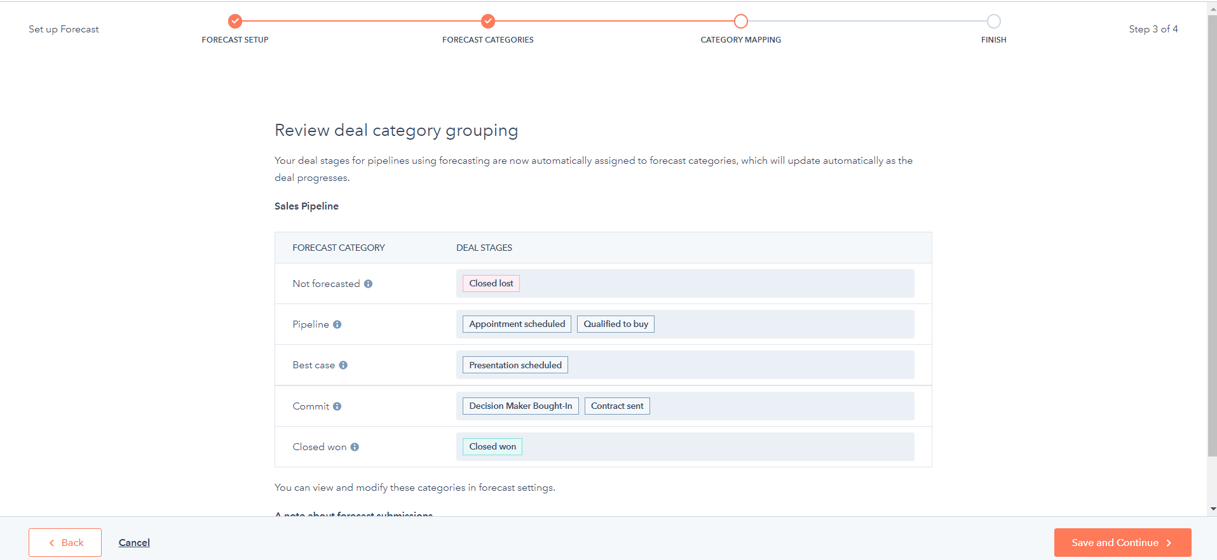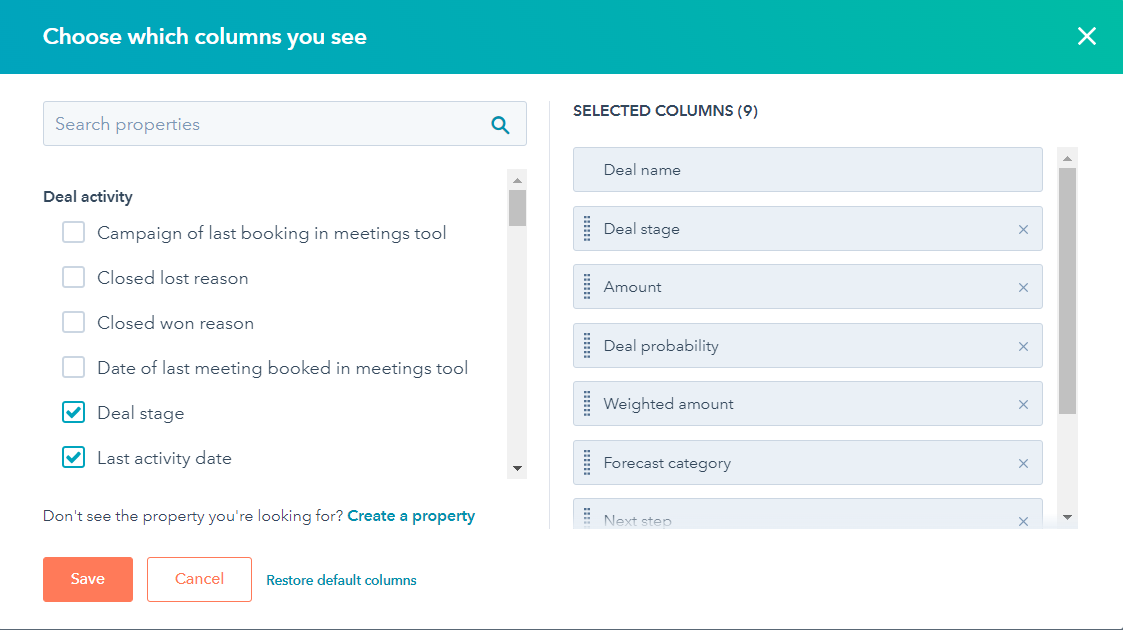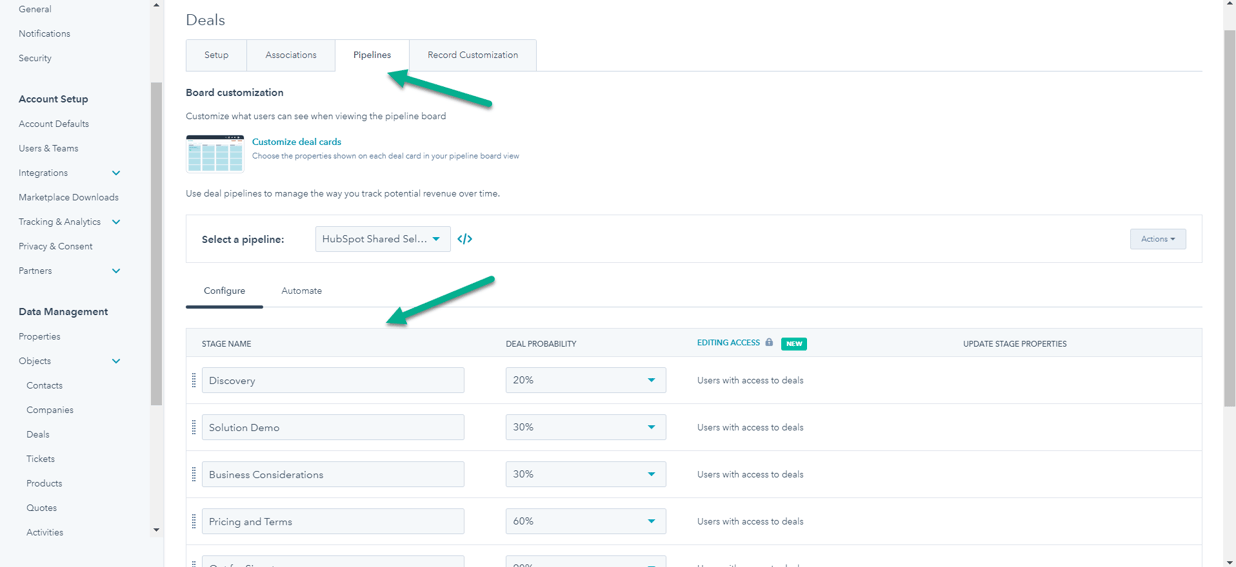What is HubSpot Sales Hub? Introduction to a One-Stop Sales Solution
HubSpot Introduction - Turbocharge your sales team with HubSpot Sales Hub. Quality more prospects into leads and convert more deals into customers.
If you're new to forecasting, and HubSpot Forecasting this blog guide is a great starting point. Get up to speed with forecasting in HubSpot now!
If you're new to the world of sales forecasting or looking for a more effective way to predict future sales, HubSpot Forecasting is an excellent place to start. Our blog guide provides a comprehensive overview of how HubSpot's forecasting tool works and how you can use it to make informed decisions about your business. As your business grows, it can be increasingly challenging to predict future sales accurately. However, with HubSpot Forecasting, you can access a powerful tool that uses historical data and machine learning to generate real-time, accurate forecasts of your future sales pipeline.
Our blog guide covers everything you need to know about generating a sales forecast, from understanding the different types of forecasts to setting realistic goals. The guide includes key topics such as the types of forecasts, setting realistic goals for your forecast, inputting data into HubSpot's forecasting tool, and tips for improving the accuracy of your forecast.
Whether you're a sales director or a business owner, HubSpot Forecasting can help you gain valuable insights into future sales, revenue, and customer behavior. With its user-friendly interface and powerful features, this tool is an essential tool for anyone looking to make data-driven decisions about their business strategy. So why not dive in and discover the power of HubSpot Forecasting?
A sales forecast is an estimate of future sales, typically based on past sales performance. Companies use sales forecasts to make decisions about where to allocate resources and how to manage growth. Sales forecasting can be done using statistical methods, judgmental methods, or a combination of both.
Sales forecasting is an important part of financial planning and business administration. It helps companies track actual sales against their goals and objectives and identify trends that could impact future sales. Additionally, forecasting can help businesses make informed decisions about inventory levels, staffing needs, and marketing budgets. A sales forecast is a projection of future sales based on past performance and current market conditions.
To generate a forecast, HubSpot analyses your sales data and looks for patterns in conversion rates, deal size, and close rate. Based on this analysis, HubSpot makes predictions about how your business will perform in the future. Use HubSpot to predict future sales outcomes and help you make informed decisions about your business.
 What is HubSpot Forecasting Tool?
What is HubSpot Forecasting Tool?
HubSpot Forecasting is a versatile tool designed to enhance the accuracy of revenue projections as your business grows. It allows sales teams to predict future performance and track progress against quotas, helping managers to adjust strategies effectively. With customisable reporting and forecast categories, teams can tailor forecasts to reflect specific needs, such as deal stages or team dynamics.
This user-friendly tool integrates seamlessly with HubSpot CRM, ensuring all sales data is current and providing real-time insights for immediate decision-making. It facilitates tracking individual and team performance against targets, identifying areas that may need additional support or improvement. Scenario planning capabilities also allow teams to prepare for various outcomes, aligning their strategies to adapt to changing business conditions.
HubSpot Forecasting removes the guesswork from sales forecasts, allowing representatives and managers to submit custom forecasts for specific periods. These can then be aggregated, giving leadership a comprehensive view of team expectations. Forecast permissions ensure that submissions are accurate and from authorised sources, supporting strategic planning and enabling more predictable sales outcomes through data-driven decisions.

Sales forecasts are essential for businesses to make informed decisions, allocate resources, and set goals. There are several types of sales forecasting methods, each with its own strengths and weaknesses. Here are some common types of sales forecasts used by varying sales teams:
Qualitative Forecasting:
Qualitative forecasting methods rely on the opinions, intuition, and expertise of salespeople, managers, or industry experts. These methods are particularly useful when there is limited historical data or when the business environment is rapidly changing. Some qualitative forecasting methods include:
Sales force composite: Salespeople estimate their individual sales for a given period, and these estimates are combined to create a forecast.
Expert opinion: Industry experts or experienced managers provide insights and estimates for future sales.
Delphi technique: A panel of experts provides individual forecasts, which are then discussed, refined, and combined to create a consensus forecast.
Quantitative forecasting methods use historical data and mathematical techniques to generate sales forecasts. These methods are more objective and typically more accurate than qualitative methods when there is sufficient historical data. Some quantitative forecasting methods include:
Time series analysis: This method involves analysing historical sales data to identify trends, seasonality, and cyclical patterns. Future sales are predicted based on these patterns.
Moving average: The moving average method calculates the average sales over a specified period and uses this average to predict future sales.
Exponential smoothing: This method assigns different weights to historical data, with more recent data given greater importance. The weighted average is used to forecast future sales.
Regression analysis: Regression analysis is a statistical method that examines the relationship between sales and one or more independent variables (e.g., marketing spend, economic indicators) to predict future sales.
Mixed Approach Forecasting:
Mixed approach forecasting methods combine elements of both qualitative and quantitative forecasting techniques. This can provide a more balanced and accurate forecast by incorporating human expertise and intuition with data-driven insights. Some mixed-approach forecasting methods include:
Judgmental adjustments: Quantitative forecasts are adjusted based on qualitative inputs, such as insights from salespeople or industry experts.
Scenario planning: Multiple sales forecasts are generated based on different assumptions, scenarios, or potential market conditions, and then combined or weighted to create a final forecast.
Each of these sales forecasting methods has its own advantages and disadvantages, and the choice of method depends on factors such as the nature of the industry, the availability of historical data, and the business's specific goals and needs.

There are many benefits of using HubSpot’s business forecasting tool. HubSpot's Forecast tool is designed to help sales teams predict and manage their sales revenue more effectively. With this tool, you can get a holistic overview of your entire pipeline and quickly dive into the details with your team. You’ll also be able to see how your quarter is going and inspect deals to make sure your team is on track. With customisable forecast categories and models, you can tailor the tool to match your business needs. The benefits of this all include:
Precise revenue forecasting:
The tool utilises historical data and machine learning algorithms to generate accurate sales forecasts, aiding sales teams in understanding their potential revenue and setting realistic targets.
Improved decision-making:
With an accurate view of the sales pipeline and future revenue, managers can make informed decisions regarding resource allocation, recruitment, and other strategic initiatives.
Enhanced accountability:
The Forecast tool offers visibility into individual and team performance, which helps motivate team members to meet or exceed their targets and fosters a culture of accountability.
Time-saving:
Automated sales forecasting saves time that would otherwise be spent on manual data analysis, allowing sales teams to concentrate on nurturing leads and closing deals.
Real-time updates:
The tool continually updates forecasts as new deals are added or existing deals progress, providing up-to-date insights into the health of the sales pipeline.
Customisable views:
Users can tailor the Forecast tool to their specific needs by customising the display, filters, and timeframes, allowing for more in-depth analysis and reporting.
Better collaboration:
By providing a shared view of the sales pipeline, the tool can improve communication and collaboration between sales team members, helping them work together more effectively towards shared goals.
Integration with other HubSpot tools:
The Forecast tool is part of the HubSpot ecosystem, which means it can be seamlessly integrated with other HubSpot sales, marketing, and customer service tools for a more comprehensive business solution.
The HubSpot forecasting tool is an integral component of the HubSpot CRM platform, designed to help businesses accurately predict and manage sales outcomes. This tool integrates various elements of your sales process into a cohesive forecasting model that offers both high-level and detailed insights into future revenues. Here’s how the HubSpot forecasting tool operates:
Data Integration:
The tool integrates data from different sections of the CRM, including deal records, interactions, and user inputs. It utilises the statuses and properties of deals such as the deal stage, probability of closing, expected close date, and deal value, to calculate forecasts.
Category Mapping:
During the setup of the forecasting tool, you map your deal stages to one of the forecast categories — Not Forecasted, Pipeline, Best Case, Commit, Closed Won. This mapping is crucial as it dictates how the revenue associated with each deal is accounted for in the forecast calculations.
Forecast Generation:
Based on the category mapping and deal data, the tool generates a forecast predicting revenue for a specified period, such as monthly or quarterly. This forecast is dynamic, updating in real-time as deal information changes. Forecasts can be viewed at various levels including individual, team, or the entire company, providing relevant insights to different stakeholders.
Customisation and Weighting:
HubSpot allows the customisation of probability weightings associated with each forecast category to better align with your historical sales data and prediction models. For instance, you might assign a higher weighting to deals in the 'Commit' category based on past performance, indicating a high closure rate for such deals.
Role-based Dashboards:
The forecasting tool offers tailored dashboards for different roles within your organisation. Sales representatives might see their personal forecasts and relevant deal details, while managers and executives can view aggregated forecasts with capabilities to drill down into specific regions, teams, or product lines.
Scenario Analysis:
HubSpot enables scenario analysis by allowing you to create multiple forecasts based on different assumptions or sales strategies. This feature is particularly useful for planning and resource allocation in response to market changes or internal strategy shifts.
Reporting and Insights:
Comprehensive reporting features are provided to help analyse the performance of past forecasts, understand reasons for variance, and improve future predictions. Insights can include pipeline velocity, win/loss analyses, and stage conversion rates, all of which are essential for refining sales strategies.
By leveraging these functionalities, the HubSpot forecasting tool enables agencies to gain a clearer understanding of future revenues, align sales activities with business goals, and make informed decisions based on data-driven insights. This can be particularly beneficial in the dynamic field of digital marketing and advertising, where market conditions and client spending can fluctuate rapidly.

In HubSpot, forecasting is tailored to give a clearer view of expected sales outcomes by categorising deals based on their likelihood of closing. Understanding and utilising these categories effectively can enhance your sales strategy and pipeline management. Here’s how these forecast categories can be structured within HubSpot:
Not Forecasted:
Description: This category includes deals that are active in your pipeline for the current period but aren't included in the forecast totals.
Purpose: It's useful for keeping track of early-stage deals or those that don't have a clear path to closure within the forecast period.
Pipeline:
Description: Deals categorised under 'Pipeline' have a low likelihood of closing.
Purpose: This category helps in monitoring deals that need further nurturing or development before they can advance to a more promising stage.
Best Case:
Description: These are deals that have a moderate likelihood of closing and will do so in the best-case scenario.
Purpose: 'Best Case' helps in identifying deals that might close if specific favorable conditions are met, providing a more optimistic outlook than the basic pipeline.
Commit:
Description: Deals in this category have a high likelihood of closing and are committed to the forecast.
Purpose: This category is critical for reliable forecasting as it contains deals that are expected to contribute significantly to the revenue in the forecast period.
Closed Won:
Description: This category is for deals that have successfully closed within the forecasted time period.
Purpose: Tracking 'Closed Won' deals is essential for assessing the accuracy of the forecast and understanding the effectiveness of the sales strategies employed.
To organise these categories, HubSpot uses a flexible system where you can select and clear checkboxes next to deal stages to include them in specific forecast categories. This approach allows you to dynamically adjust your forecast view as deals progress through stages, providing a real-time snapshot of potential revenue and enabling more strategic decision-making in your sales and marketing efforts. This system is especially useful in an advertising or digital marketing context where deal closure rates and timelines can vary significantly.
Using the HubSpot Forecast tool effectively can greatly benefit your sales teams by providing accurate sales forecasts and insights. Here are some tips to help you make the most of the tool:
Keep your data updated:
Ensure that all deals and their stages are up-to-date in your HubSpot CRM. Accurate and timely data entry is crucial for generating reliable forecasts.
Customise the tool:
Tailor the forecasting tool to your business by adjusting the deal stages, probabilities, and timeframes to match your sales process. This will help improve the accuracy and relevance of the forecasts.
Monitor individual and team performance:
Use the forecasting tool to track individual sales rep and team performance. This can help you identify areas of improvement, hold team members accountable, and provide coaching or support where needed.
Leverage historical data:
Analyse historical data to identify trends, seasonality, and patterns that may impact your sales forecasts. Incorporating this information into the forecasting tool can help refine its predictions.
HubSpot Sales Forecasting considers a variety of factors, including the number of deals in your pipeline, the size of each deal, the stage each deal is in, your close rate, and your win rate. By considering these factors, you can get a more accurate forecast.
Use a combination of forecasting methods:
Whilst HubSpot's Forecast tool relies primarily on quantitative methods, consider incorporating qualitative input from sales reps and industry experts to create a more balanced and accurate forecast.
Review forecasts regularly:
Keep an eye on the sales forecasts and make adjustments as needed based on new data or changes in the business environment. Regularly reviewing and updating forecasts helps keep them relevant and accurate.
Integrate with other HubSpot tools:
Maximise the power of HubSpot by integrating the Forecast tool with other HubSpot sales, marketing, and customer service tools. This can provide a more comprehensive view of your business and help you make more informed decisions.
Train your sales team:
Ensure your sales team understands how to use the HubSpot Forecast tool effectively. Provide training and resources to help them make the most of the tool and the insights it provides.
Analyse and learn:
Continuously analyse your forecasts and actual results to identify areas for improvement. Learn from any discrepancies between your forecasts and actual sales to refine your forecasting process over time.
Collaborate and communicate:
Encourage open communication and collaboration among your sales team members by sharing forecasts and discussing strategies, challenges, and opportunities. This can help foster a more cohesive and effective sales team.
HubSpot Sales Forecasting provides two different forecasting models: the trended model and the weighted model. The Trended Model is based on historical data and predicts future sales based on past performance. The Weighted Model gives more weight to recent HubSpot deals, which makes it more accurate for forecasting short-term sales. Try both models and see which one works better for your business.
Use the HubSpot Sales Forecasting Insights to improve your forecasts.
HubSpot Sales Forecasting provides insights on what's driving your results, so you can make changes to your sales process and improve your forecasting accuracy over time.

In conclusion, mastering HubSpot Forecasting can significantly enhance your sales strategy and decision-making processes. This powerful tool, with its capabilities to analyse past performance and predict future sales, provides invaluable insights that can help drive your business's growth. By incorporating real-time data, machine learning, and customisable forecasting categories, HubSpot enables businesses to plan more accurately and adapt swiftly to changes in the marketplace.
As we have explored, HubSpot Forecasting not only aids in achieving more accurate sales predictions but also improves overall business efficiency. It allows teams to allocate resources wisely, adjust strategies proactively, and achieve greater alignment across departments. Furthermore, the intuitive interface and integration with HubSpot CRM streamline operations, making it easier for teams to collaborate and stay on track towards their goals.
Whether you are a seasoned sales director or a budding business owner, investing time in understanding and utilising HubSpot Forecasting can lead to better informed, data-driven decisions that pave the way for sustained business success. We encourage you to delve into this tool, explore its numerous features, and start transforming your sales forecasting into one of your strongest business assets.
HubSpot Introduction - Turbocharge your sales team with HubSpot Sales Hub. Quality more prospects into leads and convert more deals into customers.
Use HubSpot to close more deals and manage your sales process more scientifically and systematic. Understand bottlenecks in the process to speed up...
HubSpot Tips everyone should know and to maximise your HubSpot Game Plan.
Be the first to know about new HubSpot nsights to build or refine your business with the tools and knowledge of today’s best practises.